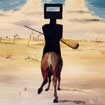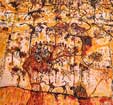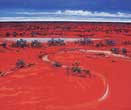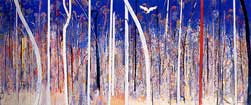|
Australia’s
indigenous heritage dates back over 40,000 years, being the world’s oldest
surviving culture. Its Anglo-Celtic history is just over 200 years old,
followed closely by a migration of people from just about every nation in
the world, today predominantly from Asia. 28% of Australians now come from
non-English speaking backgrounds, with over 200 languages spoken, making
Australia one of the most culturally diverse nations in the world.
This richness is evident in our
food, our wine and our arts and culture. The fusion of such diverse
backgrounds and insights is creating exciting and innovative results, now
shaping the identity of contemporary Australian art.
From a nation of only 19 million people (0.3% of the world’s population)
our artists
- like our sports people -
have made a big impact around the world. Household names include, from the
music scene Kylie Minogue,
Midnight Oil, Crowded House,
the Bee Gees,
AC/DC,
INXS,
Yothu Yindi,
Christine Anu, Cruel Sea,
You Am I, silverchair,
The Whitlams, Savage Garden,
Regurgitator, Paul Kelly,
Nick Cave,
Natalie Imbruglia,
Vanessa Amorosi, and Tina Turner;
actors and directors such as Nicole Kidman,
Russell Crowe, Cate Blanchett,
Mel Gibson, Judy Davis,
Greta Scacchi, Geoffrey Rush,
Gillian Armstrong, Erroll Flynn,
Peter Allen, Paul Hogan,
Scott Hicks,
Baz
Luhrmann,
Martin
Brown and
Dean Semmler; films like
Moulin Rouge,
Priscilla:Queen of the Desert,
Shine, Babe,
The Piano, My Brilliant Career,
Two Hands, Head On,
Mad Max,
Crocodile Dundee, Strictly Ballroom
and Muriel’s Wedding; in literature,
AB ‘Banjo’ Patterson (well known as the
author of Australia’s alternative national anthem, “Waltzing Matilda”),
Patrick White (Australia’s 1973
Nobel
prize-winner for literature), Miles Franklin (one of
Australia’s first feminist writers and the author of ‘My Brilliant
Career’), Thomas Keneally (well-known for his
Booker Prize-winning ‘Schindler’s Ark’, upon which the Spielberg film
‘Schindler’s List’ was based),
Peter Carey (another Booker prize winner),
David Maulof
(who has won just about every award there is to win in Australian
literature),
Tim Winton (regarded as one
of the best Australian writers today and probably the most widely read)
and David Williamson
(playwright who has gained international success);
Australian visual artists
that may sound familiar include
Sir Sydney Nolan, Arthur Boyd,
Fred Williams, John Olsen,
Charles Blackman, Brett
Whitely, Tracey Moffat,
Howard Akley
and Imants Tillers; Indigenous painters,
including Emily Kame Kngwarray,
George Milpurrurru, Mick Namarari
Tjapaltjarri,
Fiona Foley
and Maggie Napangardi
Watson are much in demand; Photographers that have met
international acclaim include Max Dupain and
his wife Olive Cotton, and more recently
William Yang, Dennis
del Favero
and Olegas Truchaneas.
Whilst our early European visual artists grappled with the unique
Australian landscape – its openness, light, distance and colour – the
subjects most embraced by Australian artists today include national
identity, the environment, technology, globalisation, reconciliation and
appropriation. Many artists are fundamentally driven by their conceptual
concerns, and often utilize unconventional mediums to challenge both
artist and audience alike.
Perhaps due to the vast distances and isolation of the continent,
Australia has one of the highest take-up rates of new technology in the
world. Australian artists today are at the forefront in exploring the
potential of new media.
Art is often presented away from the traditional art environment,
for example along the beach or projected on the Sydney opera house,
opening
up the boundaries of experimentation and
engaging
new audiences. The notion of ‘what art is?’ is often called into
question.
Although for a long time there has been a stigma hanging over the psyche
of Australian society that success could only be obtained from overseas
recognition, which resulted in many of our artists leaving home shores,
that no longer seems to apply and Australia is now nurturing it’s vibrant
art-making talent, and still developing a prominent spot on the
international scene.
In support of the wealth of talent there are a host of arts
festivals that
celebrate and cultivate Australian creative culture as well as supporting
a fine agenda of international influences.
Australia is a country rich in fresh adventurous personalities. As a
nation we are still building
our identity and as such, have no
defined lines in which we believe one must follow. Anything could
be possible, (certainly when you are surrounded by good
humour, which the Australians are commended with!) and art is
one field where this notion shines through.
'It
is a brave new world for those who dare….'
Australia, a pioneering nation made up of people from over 140 other
nations, is giving it a go! |














